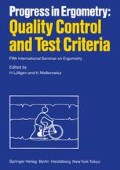Abstract
Analysis of R wave amplitude changes that occur during exercise has been proposed for the diagnosis of coronary heart disease in recent years [2,5,6–8,18–22].
Access this chapter
Tax calculation will be finalised at checkout
Purchases are for personal use only
Preview
Unable to display preview. Download preview PDF.
References
Andersen KL, Shephard RJ, Denolin H, Varnauskas E, Masironi R (1971) Fundamentals of exercise testing. World Health Organization, Geneva
Baron DW, Ilsley C, Sheiban I, Poole-Wilson PA, Richards AF (1980) R-wave amplitude during exercise. Relation to left ventricular function and coronary artery disease. Br Heart J 44: 512–517
Battler A, Froelicher V, Slutsky R, Ashburn W (1979) Relationship of QRS amplitude changes during exercise to left ventricular function and volumes and the diagnosis of coronary artery disease. Circulation 60: 1004–1013
Bayley RH, Kalbfleisch JM, Berry PM (1969) Changes in the body’s QRS surface potentials produced by alterations in certain compartments of the nonhomogeneous conducting model. Am Heart J 77: 517–528
Berman JL, Wynne J, Cohn PF (1980) Multiple-lead QRS changes with exercise testing. Diagnostic value and haemodynamic implications. Circulation 61: 53–61
Bonoris PE, Greenberg P, Castellanet M, Ellestad MH (1977) Predictive value of R-wave amplitude changes in treadmill stress testing. Circulation 56 [suppl III] (abstract)
Bonoris PE, Greenberg P, Christison G, Castellanet M, Ellestad M (1978) Evaluation of R-wave amplitude changes versus ST-segment depression in stress testing. Circulation 57: 904–910
Bonoris PE, Greenberg P, Castellanet M, Ellestad M (1978) Significance of changes in R-wave amplitude during treadmill stress testing: angiographic correlation. Am J Cardiol 41: 846–851
Brody DA (1956) A theoretical analysis of intracavitary blood mass influence on heart-lead rela-tionship. Circ Res 4: 731–739
David D, Naito M, Chen CC, Mishelson EL, Morganroth J, Schaffenburg M (1981) R-wave amplitude variations during acute experimental myocardial ischemia: an inadequate index for changes in intracardiac volume. Circulation 63: 1364–1374
Deanfield JE, Davis G, Mongiadi F, Savage C, Selvin PA, Fox KM (1983) Factors influencing R-wave amplitude in patients with ischaemic heart disease. Br Heart J 49: 8–14
Ellestad MH, Cooke BM, Greenberg PS (1979) Stress testing. Clinical application and predictive capacity. Prog Cardiovasc Dis 21: 431–460
Eenige Van MJ, Feyter De PJ, Jong De JP, Roos JP (1982) Diagnostic incapacity of exercise-induced QRS wave amplitude changes to detect coronary artery disease and left ventricular dysfunction. Eur Heart J 3: 9–16
Harris FJ, Lee G, Mason DT (1980) Detection of treadmill exercise induced myocardial ischemia in coronary disease with conduction abnormalities at rest: comparison of ST and R-wave change. Clin Res 28: 178A
Hirschfeld SS (1982) Ventricular interdependence during exercise in cystic fibrosis. Chest 82: 524–525
Ilsley C, Canepa-Anson R, Langley G, Foale R, Poole-Wilson P, Rickards A (1981) R-wave amplitude and left ventricular volume: changes with nitroglycerine and atrial pacing. Cardiology 68 [Suppl 2]: 153–160
Iskandrian AS, Hamid Hakki H, Horowitz L, Mintz GS, Anderson GJ, Kane SA, Segal BL (1982) Changes in R-wave during exercise: correlation with left ventricular function and volumes. J Electrocardiol 15: 199–203
Janota M, Fabian J, Rohac J, Belan A (1983) The diagnostic value of R-wave amplitude changes during exercise testing. Cor Vasa 25: 168–176
Kaku R, Lee G, Lui H (1980) R-wave amplitude analysis during exercise testing reliably detects coronary disease in patients receiving digitalis. Clin Res 28: 185A
Kentala E, Luurila O (1975) Response of R-wave amplitude to postural changes and to exercise. Ann Clin Res 7: 258–263
Lee V, Lee G, Joye JA (1980) Effect of nitroglycerin on V5 R-wave amplitude in coronary patients with normal versus elevated left ventricular preload. Clin Res 28: 190A
Lee G, Mason DT, Low R (1980) Evaluation of markedly increased R-wave amplitude during spontaneous myocardial ischemic episodes in patients with variant angina. Clin Res 28: 191A
Lekven J, Chatterjee K, Tyberg JV, Parmley WW (1979) Reduction in ventricular endocardial and epicardial potentials during acute increments in left ventricular dimensions. Am Heart J 98: 200–207
Lerman J, Mele E, Chiozza M, Swetlize H, Perosio AM (1981) Effects of nitrates on R-wave variations after exercise in coronary heart disease. Chest 80: 137–141
Roberts DE, Hersh LT, Scher AM (1979) Influence of cardiac fiber orientation on wavefront voltage, conduction velocity, and tissue resistivity in the dog. Circ Res 44: 701–714
Simoons ML, Hugenholtz PG (1975) Gradual changes of wave form during and after exercise in normal subjects. Circulation 52: 570–577
Stool E, Mullins C, Leshin S, Mitchell J (1974) Dimensional changes of the left ventricle during acute pulmonary arterial hypertension in dogs. Am J Cardiol 33: 868–872
Vine DL, Finchum RN, Dodge HT, Bancroft WH, Hurst DC (1971) Comparison of the vector-cardiogram with the electrocardiogram in the prediction of left ventricular size. Circulation 43: 547–558
Wagner S, Cohn K, Selzer A (1979) Unreliability of exercise induced R-wave changes as indexes of coronary artery disease. Am J Cardiol 44: 1241–1246
Wise RA, Robotham JL, Summer WR (1981) Effects of spontaneous ventilation on the circulation. Lung 159: 175–186
World Health Organisation (1973) Evaluation of comprehensive rehabilitation and preventive programmes for patients after acute myocardial infarction. Regional Office for Europe, Copen-hagen/Euro 8206 (8)
Editor information
Editors and Affiliations
Additional information
I thank Edit KOrom and Bogdán Lászlóné for assistance in the preparation of this manuscript and Sándor Pátzay and László Rigó for the statistical analysis
Rights and permissions
Copyright information
© 1984 Springer-Verlag Berlin Heidelberg
About this paper
Cite this paper
Tahy, A. (1984). R Wave Response and Exercise ECG. In: Löllgen, H., Mellerowicz, H. (eds) Progress in Ergometry: Quality Control and Test Criteria. Springer, Berlin, Heidelberg. https://doi.org/10.1007/978-3-642-69844-6_18
Download citation
DOI: https://doi.org/10.1007/978-3-642-69844-6_18
Publisher Name: Springer, Berlin, Heidelberg
Print ISBN: 978-3-540-13570-8
Online ISBN: 978-3-642-69844-6
eBook Packages: Springer Book Archive

